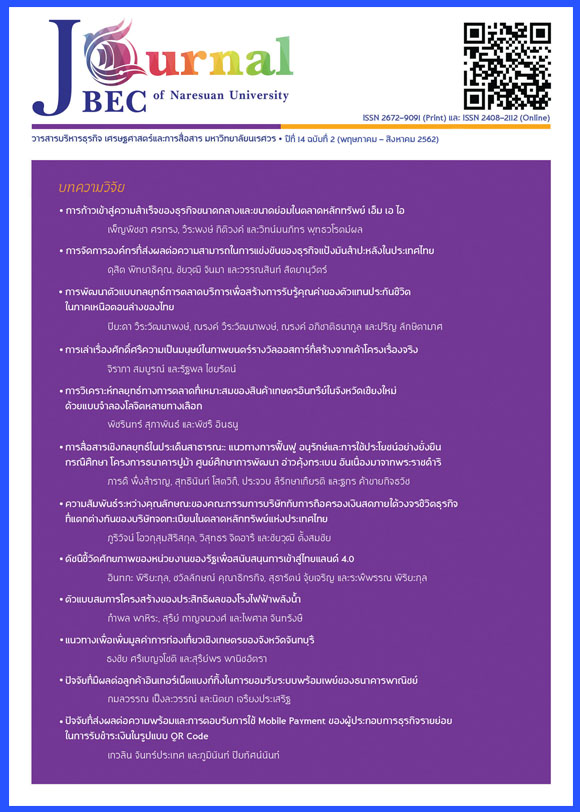ปัจจัยที่ส่งผลต่อความพร้อมและการตอบรับการใช้ Mobile Payment ของผู้ประกอบการธุรกิจรายย่อยในการรับชำระเงินในรูปแบบ QR Code Merchants’ Readiness and Acceptance of QR Code Payment Adoption
Main Article Content
บทคัดย่อ
งานวิจัยนี้ศึกษาถึงความพร้อมและการตอบรับการใช้ Mobile Payment ของผู้ประกอบการธุรกิจรายย่อยในการรับชำระเงินด้วย QR Code บนพื้นฐานแบบจำลองการยอมรับนวัตกรรมและเทคโนโลยี (Technology Acceptance Model: TAM) รวมถึงพิจารณาปัจจัยอื่น ๆ อีก 5 ปัจจัยเพิ่มเติม โดยงานวิจัยนี้เป็นงานวิจัยเชิงคุณภาพที่ใช้วิธีการสัมภาษณ์แบบเชิงลึกด้วยรูปแบบคำถามลักษณะปลายเปิด จากร้านค้าธุรกิจรายย่อย จำนวน 25 ราย และกลุ่มผู้บริหารธนาคารพาณิชย์ จำนวน 4 ราย จาก 3 ธนาคารหลักที่ให้บริการที่ได้รับการอนุมัติสามารถให้บริการมาตรฐาน QR Code ซึ่งผลการวิจัยพบว่า ปัจจัยด้านการรับรู้ถึงประโยชน์ที่ได้รับ การรับรู้ความง่ายในการใช้งาน ต้นทุนการใช้บริการ ผลกระทบภายนอกจากเครือข่าย ความปลอดภัยและความไว้วางใจ ความเชี่ยวชาญนวัตกรรมส่วนบุคคล และความต้องการเพิ่มประสบการณ์ที่ดีแก่ลูกค้า เป็นปัจจัยที่ส่งผลต่อความพร้อมและการตอบรับของร้านค้าธุรกิจรายย่อยที่จะเลือกใช้บริการ QR Payment นอกจากนี้ยังพบว่า ร้านค้าธุรกิจรายย่อยส่วนใหญ่มีทัศนคติที่ดีต่อการรับชำระเงินด้วย QR Payment และมีแนวโน้มที่จะใช้ต่อไปในอนาคต
Article Details
เอกสารอ้างอิง
2. Chareonwongsak, K. (2014). Business opportunities of Asia’s century. Journal of Business, Economics and Communications, 9(1), 3-10.
3. Chen, L. D. (2008). A model of consumer acceptance of mobile payment. International Journal of Mobile Communications, 6(1), 32-52.
4. Chitrattanamongkol, T. (2018). The influence of consumer’s expectation toward electronic service quality, usefulness and ease of use on their acceptance of QR Code technology in payment in Bangkok. Independent Study, M.B.A., Bangkok University, Bangkok.
5. Davis, F. D. (1989). Perceived usefulness, perceived ease of use and user acceptance of information technology. MIS Quarterly, 13(13), 319-340.
6. Denzin, N. K. (1978). The research act: A theoretical orientation to sociological methods. New York: McGraw-Hill.
7. Hayashi, F. and Bradford, T. (2014). Mobile payments: Merchants' perspectives. Federal Reserve Bank of Kansas City Economic Review, 99(2), 33-58.
8. Karaket, W. (2016). Fintech adoption in mobile payment startup industry. Master Thesis, M.S., Thammasat University, Bangkok
9. Katz, M. L. and Shapiro, C. (1985). Network externalities, competition and compatibility. The American Economic Review, 75(3), 424-440.
10. Kim, C., Mirusmonov, M. and Lee, I. (2010). An empirical examination of factors influencing the intention to use mobile payment. Computers in Human Behavior, 26(3), 310-322.
11. Liebana, F. C., Ramos de Luna, I. and Montoro-Ríos, F. J. (2015). User behavior in QR mobile payment system: The QR payment acceptance model. Technology Analysis and Strategic Management, 27(9), 1031-1049.
12. Liguo, L., Zilu, T. and Joon, K. (2017). Tourist satisfaction enhancement using mobile QR code payment: An empirical investigation. Sustainability, 9(7), 1186-1199.
13. Lin, C. P. and Bhattacherjee, A. (2008). Elucidating individual intention to use interactive information technologies: The role of network externalities. International Journal of Electronic Commerce, 13(1), 85-108.
14. Lohawatanakul, S. (2015). Reveal mega trends to AEC. Journal of Business, Economics and Communications, 10(1), 1-3.
15. Mallat, N. (2007). Exploring consumer adoption of mobile payments–A qualitative study. The Journal of Strategic Information Systems, 16(4), 413-432.
16. Miles, M. B., Huberman, A. M. and Saldana, J. (2014). Qualitative data analysis: A method sourcebook (3rd ed.). Arizona: SAGE.
17. National-ePayment. (2016). Project 1: PromptPay. Retrieved February 7, 2018, from http://www.epayment.go.th/home/app/project-1
18. Patton, M. Q. (1999). Enhancing the quality and credibility of qualitative analysis. HSR: Health Services Research, 34(5), 1189-1208.
19. Pholphirul, P. (2007). Demand of network and telecommunication products. Retrieved March 12, 2018, from http://piriya-pholphirul.blogspot.com/2007/02/blog-post.html
20. Terdtultaweedech, N. (2016). Cashless society: Get ready for full cashless society. Retrieved February 7, 2018, from https://www.scbeic.com/th/detail/product/2602
21. Thansettakij. (December 31, 2017). “QR code” is rising. Thansettakij, 37(3,327), 20.
22. Ueasangkomsate, P. (2016). Barriers to e-commerce adoption in Thai Small and Medium Enterprises. Journal of Business, Economics and Communications, 11(2), 33-45.
23. Umphapalin, P. (2018). Factor affecting behavior intention to use Quick Response payment system of consumer in Bangkok. Master Independent Study, M.B.A., Bangkok University, Bangkok.
24. Vierra, T. (2010). Factors influencing the acceptance of mobile payment among mobile phone users in Bangkok. Independent Study, M.S., Thammasat University, Bangkok.
25. Wang, C. C., Lo, S. K. and Fang, W. (2008). Extending the technology acceptance model to mobile telecommunication innovation: The existence of network externalities. Journal of Consumer Behavior, 7(2), 101-110.
26. Xiang, V. (2017). What do you need to know about QR Code pay?. Retrieved March 7, 2018, from www.linkedin.com/pulse/what-do-you-need-know-qr-code-pay-vincent-xiang
27. Yang, S., Lu, Y., Gupta, S., Cao, Y. and Zhang, R. (2012). Mobile payment services adoption across time: An empirical study of the effects of behavioral beliefs, social influences and personal traits. Computers in Human Behavior, 28(1), 129-142.


